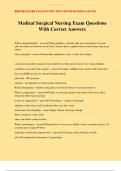BRIGHTSTARS EXAM STUDY SOLUTIONS 8/15/2024 2:05 PM
Medical Surgical Nursing Exam Questions
With Correct Answers
What is hypermetropia? - answer✔✔long sitedness, whereby light ray convergence at a point
after the retina, and therfore out of focus. Nearby objects apphear blurry while distant objects are
clearer
what is myopia? - answer✔✔near/short sightedness, close is clear, far is blurry
-usual starts in puberty and gets worse untill eye is fully grown. also in very young children.
conditions associated with myopia? - answer✔✔squint- childhood eyes point in diff. directions.
lazy eyechildhood, one eye. doesnt develop properly
glaucoma - IOC pressure.
cataracts - develpoment of cloudy atches inside lense.
Retinal detachment - wherby retina pulls awat from the blood vessel that nourish it
What is astigmatism? - answer✔✔Failure to converge image at one point on the fovea (likea
refraction rather than focusing)
Causes of astigmatism? - answer✔✔-Hereditary - corneal or lenticular
-Injuries to the cornea, such as infection that scars the cornea
keratoconus & kertoglobus - causes bulgin, thinner and shape change.
Some conditions of the eyelid
others that affect cornea or lense
What is presbyopia? - answer✔✔gradual loss of your eyes' ability to focus on nearby objects. It's
a natural part of aging 40-65yrs
Aetiology of bacterial conjunctivitis? - answer✔✔S.Aureus, Sterp. Pneumo or H.flu
also STIs chlamydia trachromatis, N.gonnorheae
,BRIGHTSTARS EXAM STUDY SOLUTIONS 8/15/2024 2:05 PM
what is opthalmia neonatorum? - answer✔✔chlamydia or gonorrheae infection from infected
birth canal affecting 20-40%
What is Episcleritis ? - answer✔✔Inflamationof localiased superficial episclera vascular
network, most commonly diffuse (moderate to sever inflam @1-3 month intervals)
-Nodular/focal episcleritis (can often present with associated systemic disease)
What are the classification of Allergic conjunctivitis? - answer✔✔type 1 hypersensitivity -
seasonal (SAC)
perrenial - chronic (PAC)
Atopic - relates to eczema and athsma
gaint pappilary (GPC)
Limbal and tarsal kertaoconjuctivitis (VKC)
What is gaint pappilary Allergica conjunctivitis - answer✔✔inner lining of the eyelid swells and
develops small bumps. Known as papillae, these bumps tend to form after chronic irritation
what can cause a corneal abbration? - answer✔✔Direct trauma
Foreign body between eyelid and conjunctiva
Heat by contact
UV radiation (Arc Eye)
What can cause corneal ulcer? - answer✔✔can be secondary to abrasive trauma, pentrating
injuries or prolonged use of contact lenses
What are dendritic ulcers? - answer✔✔Herpes simplex virus (HSV) keratitis is the most frequent
cause of corneal blindness.
- aggressive treatment -
Symptoms of Dendritic ulcers? - answer✔✔Pain
Photophobia
Blurred vision
Tearing
Redness
- with fluorescein staining and has a delicate branching pattern,
Appearance of dendritic ulcer on opthalmoscopy? - answer✔✔- infectious epithelial keratitis
(with characteristic dendritic ulcers)
,BRIGHTSTARS EXAM STUDY SOLUTIONS 8/15/2024 2:05 PM
-neurotrophic keratopathy
-stromal keratitis endotheliitis (classified as disciform, diffuse, or linear)
what are the symptoms of keratic precipitates and anterior uveitis - answer✔✔Pain, generally
developing over a few hours or days except in cases of trauma:
Redness
Photophobia
Blurred vision
Increased lacrimation
Chronic anterior uveitis presents primarily as blurred vision and mild redness.
pain & photophobia normaly only during acute episode.
what are the symptoms of posterior Uveitis? - answer✔✔Blurred vision and floaters
Absence of symptoms of anterior uveitis (ie, pain, redness, and photophobia)
All parts of the posterior chamber may be affected, including the retina, choroid and optic nerve.
It can be caused by bacterial, fungal, viral and parasitic infections.
What are the findings of posterior Uveitis upon opthalmoscopy? - answer✔✔posterior uveitis
Showing candle wax drippings (white areas)
Anterior uventis is linked to which non infectious diseases? - answer✔✔-Ankyolising
spondilitis,
-behcet syndrom (ulcers eye,mouth & genitals),
-IBS,
-Juvenile arthritis, sarcoidosis (Granulomatous disease),
-seronegative arthropathy
Anterior uventis is linked to which infectious diseases? - answer✔✔HSV, SYphilis, TB &
varicella zoster
Intermediate uventis (Cillary body to retina) is linked to which non-infectious disease? -
answer✔✔Lymphoma, MS and sarcoidosis
Posterior uventis (Retina, retinavvessels) and Panuverntis (iris, cilliary body and choroid layer) -
is linked which non-infectious diseases? - answer✔✔Behcets sydrome, lymphoma, sarcoidosis2
, BRIGHTSTARS EXAM STUDY SOLUTIONS 8/15/2024 2:05 PM
Posterior uventis (Retina, retinavvessels) and Panuverntis (iris, cilliary body and choroid layer) -
is linked which infectious diseases? - answer✔✔CMV, endogenous encephalitis, syphalis. TB
and varicella zoster
Toxicaris & toxoplasmosis
Workup for suspected uveitis? - answer✔✔CBC, ESR, Antinuclear antibody (ANA),
Rapid plasma reagin (RPR)
Venereal disease research laboratory (VDRL)
Lyme titer
HLA testing for ankylosing spondylarthroses
Chest radiography (to assess for sarcoidosis or tuberculosis)
Urinalysis (for red blood cells or casts)
Infectious workup (eg, HIV, toxoplasmosis), depending on the presentation
What is a HYPOpyon - answer✔✔It is a leukocytic exudate, seen in the anterior chamber,
usually accompanied by redness of the conjunctiva and the underlying episclera
-often co-inside with behcets disease, endophthalmitis, panuveitis/panopthalmitis & Averse drug
reactions
what are anterior synchiae? - answer✔✔Peripheral anterior synechiae (PAS)
Adhesions between the iris and trabecular meshwork
PAS result from prolonged appositional contact between the iris and trabecular meshwork
PAS may reduce outflow of aqueous humor
May lead to raised intraocular pressure
What are floaters? - answer✔✔Spots, threads, or fragments of cobwebs, which float slowly
before the observer's eyes
commony collagen breaking down to fibrils, retinal tears and tear film debris of conjuctival
surface
what are cateracts and how will a pateint present? - answer✔✔Gradual thickening of the lens.
Hx of progressive residual deteriation and disturbance in night & near vision




